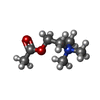+検索条件
-Structure paper
| タイトル | Structural and dynamic insights into supra-physiological activation and allosteric modulation of a muscarinic acetylcholine receptor. |
|---|---|
| ジャーナル・号・ページ | Nat Commun, Vol. 14, Issue 1, Page 376, Year 2023 |
| 掲載日 | 2023年1月23日 |
 著者 著者 | Jun Xu / Qinggong Wang / Harald Hübner / Yunfei Hu / Xiaogang Niu / Haoqing Wang / Shoji Maeda / Asuka Inoue / Yuyong Tao / Peter Gmeiner / Yang Du / Changwen Jin / Brian K Kobilka /     |
| PubMed 要旨 | The M2 muscarinic receptor (M2R) is a prototypical G-protein-coupled receptor (GPCR) that serves as a model system for understanding GPCR regulation by both orthosteric and allosteric ligands. Here, ...The M2 muscarinic receptor (M2R) is a prototypical G-protein-coupled receptor (GPCR) that serves as a model system for understanding GPCR regulation by both orthosteric and allosteric ligands. Here, we investigate the mechanisms governing M2R signaling versatility using cryo-electron microscopy (cryo-EM) and NMR spectroscopy, focusing on the physiological agonist acetylcholine and a supra-physiological agonist iperoxo, as well as a positive allosteric modulator LY2119620. These studies reveal that acetylcholine stabilizes a more heterogeneous M2R-G-protein complex than iperoxo, where two conformers with distinctive G-protein orientations were determined. We find that LY2119620 increases the affinity for both agonists, but differentially modulates agonists efficacy in G-protein and β-arrestin pathways. Structural and spectroscopic analysis suggest that LY211620 stabilizes distinct intracellular conformational ensembles from agonist-bound M2R, which may enhance β-arrestin recruitment while impairing G-protein activation. These results highlight the role of conformational dynamics in the complex signaling behavior of GPCRs, and could facilitate design of better drugs. |
 リンク リンク |  Nat Commun / Nat Commun /  PubMed:36690613 / PubMed:36690613 /  PubMed Central PubMed Central |
| 手法 | EM (単粒子) |
| 解像度 | 3.16 - 3.32 Å |
| 構造データ | EMDB-25748, PDB-7t8x: EMDB-25749, PDB-7t90: EMDB-25751, PDB-7t94: EMDB-25752, PDB-7t96: |
| 化合物 |  ChemComp-ACH:  ChemComp-HOH:  ChemComp-2CU: |
| 由来 |
|
 キーワード キーワード | MEMBRANE PROTEIN / GPCR / signaling complex / muscarinic receptor / acetylcholine |
 ムービー
ムービー コントローラー
コントローラー 構造ビューア
構造ビューア 万見文献について
万見文献について











 homo sapiens (ヒト)
homo sapiens (ヒト)
